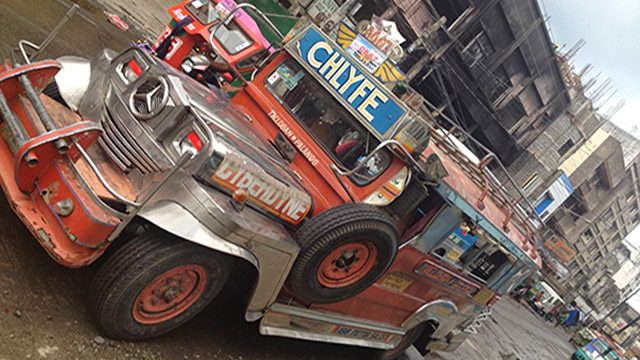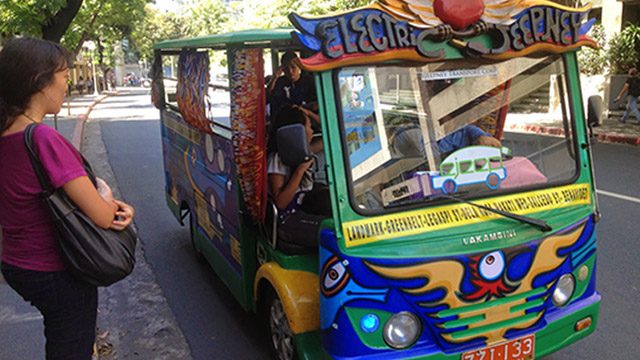SUMMARY
This is AI generated summarization, which may have errors. For context, always refer to the full article.

It is a bright, sunny morning in steamy Metro Manila.
Men in wilting business suits and women waving folding hand fans scuttle into the shady respite offered by blue construction tarpaulins billowing overhead. Yet another new office high rise being built, squeezed into the bursting Manila skyline.
Carefully skipping over mud puddles of cement mix, I follow the pedestrians hustling down P. Tuazon Avenue sharing the roadway with brawny buses, swerving motorcycles, honking taxis, and the iconic, kaleidoscopic jeepneys.
I am in the Philippines visiting the Institute for Climate and Sustainable Cities (iCSC) – a local Filipino NGO focused on community empowerment and clean energy solutions. They birthed the famous eJeepney, an electric battery powered version of the local minibus – a successful first fruit of clean, electric public transportation for the developing world.
With a surging population of almost 12 million, metropolitan Manila is one of the emerging cities of Southeast Asia and cleaner, cheaper ways of transporting throngs of people to and fro are now imperative.
As the city blossoms, it also becomes more vulnerable to the impact of natural disasters – something the island archipelago is already familiar with. Memories of Typhoon Yolanda hang in the air of our discussion at the iCSC head office, a groovy alcove of repurposed furniture and hand-painted windows overlooking an old trade fair.
“Filipinos have been adapting since before it was en vogue,” Red chuckles.
Renato “Red” Constantino is the executive director of iCSC and all-around visionary.
“Mitigation, adaptation, can we truly separate these ideas?” he asks, with palms outstretched, as though holding the very words in his hands. A tattoo serpent slithers up his left arm and his wrists are banded with a charming collection of bracelets and amulets.
With spikey black and gray peppered hair and red worn boots, he is the stuff of adventure tales. “It is not about warding off danger or merely coping with the times. It is about building better, healthier, stronger, resilient cities, no matter what the future holds.”
His philosophy is compelling and indeed, iCSC has had recent success lobbying the government for a legislative fund to support community capacity building – aptly named the People’s Survival Fund.
Red’s team is a select handful of policy experts and technology managers, all home-grown and passionate about environmental activism in the Philippines.
Reina Garcia has worked for the eJeepney program since its inception in 2005. She takes me out to see the fleet in action.

iCSC has found local battery manufacturers and local electric vehicle manufacturers able to assemble the eJeepneys at low cost.
Made of lightweight steel and without the need for a rumbling diesel engine, the eJeepney offers a quieter, cooler ride to passengers, all while reaping the savings from no fuel cost.
An iCSC subsidiary now operates 20 eJeepneys, routed throughout the metropolitan region. iCSC hopes that the model will be adopted by other jeepney operators in the near future.
“They’ve integrated quite seamlessly,” Reina tells me. “Anyone would jump into an eJeepney, most without even knowing they are in an electric vehicle.”
We hop into one for a ride to the charging station and chat with some of the drivers – all women.
In fact, half the fleet is operated by female drivers, an iCSC strategy to promote employment equality. It is refreshing to see a simple, functional operation working so steadily for years in the tropics. It parallels the team’s action-oriented tone of simplicity and efficiency.
Bottom-up technologies that work: no catch, no twist, no hidden charges.
These are exactly the types of solutions that the Philippines needs right now, especially in the wake of Typhoon Yolanda and with the promise of stronger, larger storms to come. Yolanda struck the Philippines last November 2013 and went down in history as the strongest typhoon ever to make landfall in recent history.
I got the chance to visit Leyte, the island most devastated by Yolanda, and Tacloban, its capital – which was completely leveled. It was a tremendously moving experience.
From the moment of getting off the plane at the ghostly remains of the airport, it felt like being on the set of an eerie end-of-times post-apocalyptic movie.
Rows and streets of houses, churches, malls, completely reduced to rubble. Ships stranded hundreds of meters inland. Blue and white relief aid tents stretched for miles on end.
But Tacloban is more than that now.
iCSC is now expanding the eJeepney operation here, to be part of the response and rebuild efforts as transportation is still a scarcity.

Every so often a jeepney passes by with people piled onto the roof, risking limb for a precious ride into or out of the city.
Teddy Arellano is the project manager for setting up the eJeepney operations in the city, and he lets me tag along as he travels through Tacloban surveying the new operation sites, signing leases, meeting contractors.
The eJeepney holding bay and charging station will be solar-powered, Teddy tells me, and they want to try a new idea: mobile charging stations – driving the eJeepneys to communities still left without electricity and charging phones, radios, anything, through the vehicle’s batteries.
“It will be our little experiment,” laughs the affable Teddy with a playful smile. Someone has to be willing to take the risk to see what works, what sticks. As we travel through the torn city I marvel at his calm and ease. Teddy greets everyone we meet with a comforting familiarity, jokes ready in hand.
He chats up families with deep condolence but also with a pleasantness that makes the air less solemn. He points out to me all the progress, the new stores, the neighbor helping neighbor rebuild what was lost.
Positive, purposed, and practical, the iCSC team speaks volumes to me about the true meaning of bottom-up engagement. They are not in the business here of bemoaning tragedy or laying blame to a slow emergency response.
Rather, the team is taking up the challenge and opportunity to study a new technology’s usefulness and economy in the space of most urgent need.
Unlike the stormy waters, sorrow and pain have not yet subsided in the Philippines, but human nature is resilient.
If I’ve learned anything from my time with iCSC, it is that hope can bring the change that people need. Hope can make ideas reality. Hope can stand as the foundation for resilient cities of the future.
I’ll be sure to stay posted on the eJeepney’s journey to Tacloban. – Rappler.com
Rebekah Shirley is currently a PhD student with the Energy and Resources Group (ERG) at the University of California, Berkeley where she also obtained a MSc. Energy and Resources and a MSc. Civil Engineering. She obtained her Bachelor of Arts and Science in Environment from McGill University. She is from Trinidad and Tobago and worked there doing environmental impact assessment for energy projects prior to Berkeley.
Add a comment
How does this make you feel?
There are no comments yet. Add your comment to start the conversation.